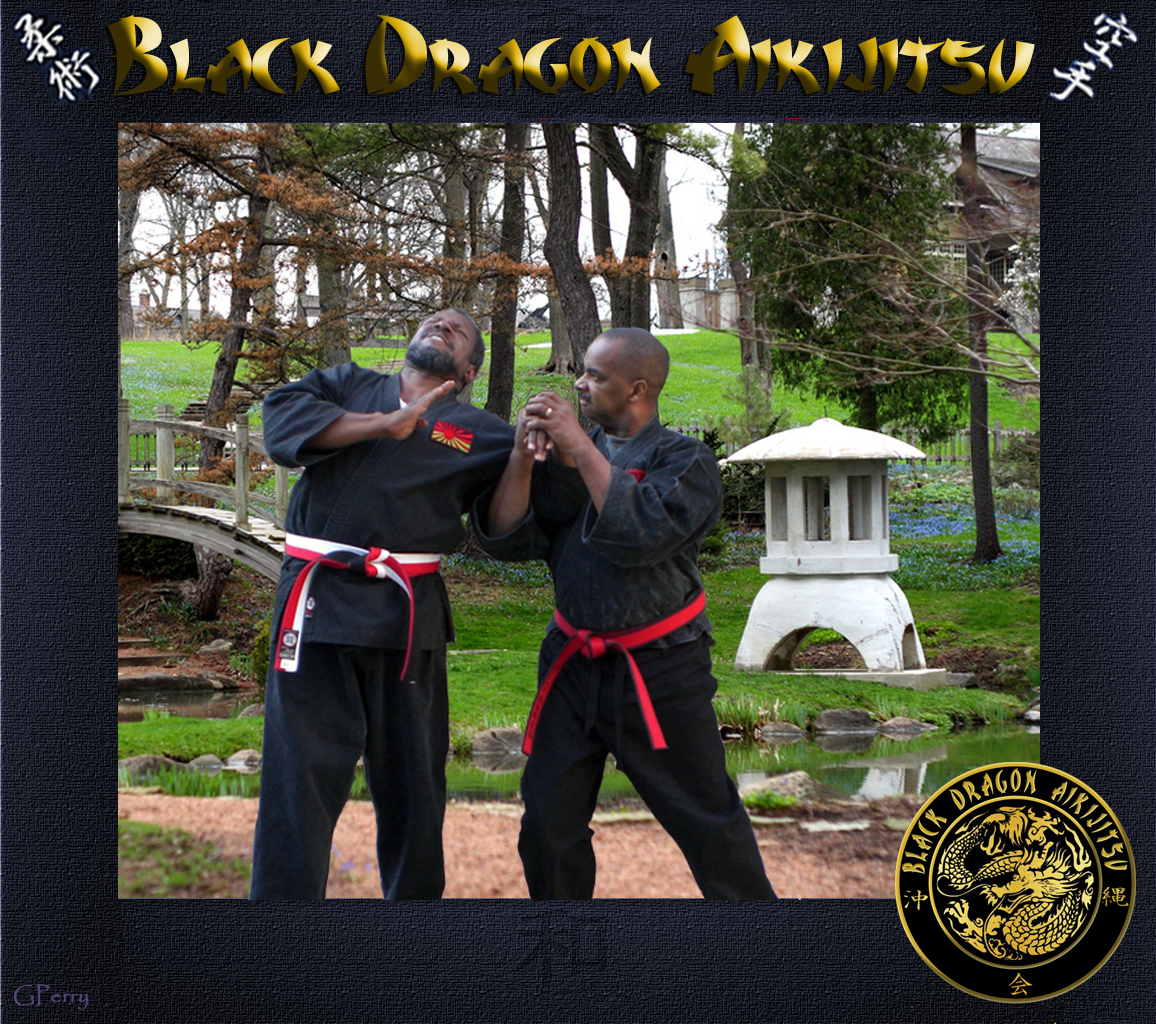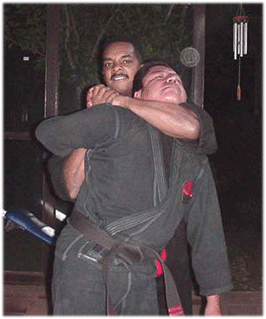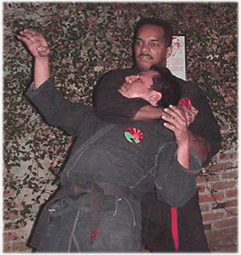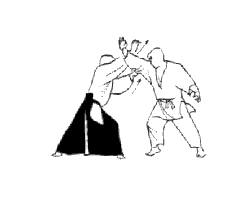GOSHIN RYU BUJUTSU
(Martial Ways or Warrior Arts)
 "GOSHIN" means Self-Defense and "Protection of the Body" in Japanese, is defined as a modern martial art system primarily based on Japanese Ju Jutsu. Frequently it is a Bujutsu system or comprehensive modern martial art. These systems have a primary focus on modern day self defensive tactics, and less focus on traditional or classical techniques. An example would be many of the modern systems that go by the name "Ju Jutsu," but which do not have links to the traditional jujutsu systems (such as Tenjin Shinjo Ryu, Yagyu Shingan-Ryu Jujutsu, Miyama-ryu Jujutsu, Budoshin Jujutsu, and Ketsugo-ryu Jujutsu).
"GOSHIN" means Self-Defense and "Protection of the Body" in Japanese, is defined as a modern martial art system primarily based on Japanese Ju Jutsu. Frequently it is a Bujutsu system or comprehensive modern martial art. These systems have a primary focus on modern day self defensive tactics, and less focus on traditional or classical techniques. An example would be many of the modern systems that go by the name "Ju Jutsu," but which do not have links to the traditional jujutsu systems (such as Tenjin Shinjo Ryu, Yagyu Shingan-Ryu Jujutsu, Miyama-ryu Jujutsu, Budoshin Jujutsu, and Ketsugo-ryu Jujutsu).
Goshin Ryu Bujutsu is the modern form of that ancient art, being continuously developed and constantly evolving to adapt to today's street self defense situations. The art of Goshin Ryu Bujutsu combines Ju Jutsu - Karate and Zen concepts and it covers most self defense situations that you would be likely to encounter on today's streets and allows its practitioners a full range of approrate techinques to the given attack-defense situation.
BUDO and BUJUTSU are Japanese terms describing martial arts. In English, they used almost exclusively in reference to Japanese martial arts.
Budo is a compound of the word bu, meaning war or martial; and do, meaning path or way. Specifically,do is derived from the Buddhist Sanskrit marga (meaningthe 'path' to enlightenment). The term refers to the idea of formulating propositions, subjecting them to philosophical critique and thenfollowing a 'path' to realize them. Do signifies a 'way of life'. Do in the Japanese context, is experiential term, experiential in the sense that practice (the way of life) is then orm to verify the validity of the discipline cultivated through a given art form. The modern budo has no external enemy, only the internal enemy, one's ego that must be fought (state of Muga-mushin). Similarly to budo, bujutsu is a compound of the words bu,and jutsu, meaning science, craft, or art. Thus, budo is most often translated as "the way of war", or "martial way", while bujutsu is translated as "science of war" or "martial science." However, both budo and bujutsu are used interchangeably in English with the term "Martial Arts".
Budo vs. Bujutsu
It can be a little difficult to precisely delineate the differences between BUDO and BUJUTSU. Sometimes, the differences are considered historical; others say the differences are in the training methods, training philosophy, or emphasis on spiritual development. Although the distinction was first popularized in the 1960s, many consider the difference a false construct with no historical basis. In Goshin Ryu we believe that Japanese Martial Arts are divided into two separate and very distinct categories; Bujutsu and Budo.
BUJUTSU is the older of the two and are quite literally the “Martial Arts” of Japan with the goal being the absolute effective application of fighting techniques in combat situations. BUDO is the younger of the two categories and traditionally there is no Budo form of an art without its Bujutsu parent. The Budo are literally the “martial ways” of the Japanese fighting arts.
BUDO or Martial Ways, in contrast to Bujutsu, are far less concerned with practical and realistic application of techniques in the modern age, but much more focused on the perfection of the moral fiber of the individual Budo student. In essence, the goal is to translate what the student learns in the dojo and apply it to everyday life. A famous statement by Karate master, Sensei Gichin Funakoshi summarizes the concept of Budo clearly, “The ultimate aim of Karate lies not in victory or defeat, but in the perfection of the character of its participants.”
New vs. Old
During Japan's feudal era, the word Bujutsu was more commonly used to describe martial practices than Budo. Likewise,terms for specific martial arts such as Ju Jutsu, Ken-Jutsu,and Iai Jutsu were already in use. During Japan's transition from a feudal to an industrial society, many schools of martial arts changed the suffix of the arts they were practicing from "jutsu" to "do". The intent of this change was in part to reflect a philosophical approach to training, where the spiritual and moral virtues of the martial arts are incorporated into one's entire life. Whether the change in philosophy actually occurred,never occurred, or whether that philosophy was always incorporated and is open to debate.
Today, so-called "traditional" martial arts (from before the Meiji Restoration) are often referred to as Koryu bujutsu ("old-style martial art/science"), while more modern martial arts are called Gendai Budo ("modern martial way").
Individual preference
There is no test or standard to determine the classification,and it is certainly possible to consider these distinctions illusory.Generally speaking, a school of martial arts chooses whateverterm they feel most comfortable with. A martial arts school might choose to call their practice bujutsu, because they desire a connection with the past, or to emphasize that their art is practiced as it was during a certain point in history. A school might choose to call their practice budo to reflect an emphasis on spiritual and philisophical development, or simply to reflectthat the art was developed more recently, such as aikido, whichwas synthesized by its founder during the early twentieth century (the older name is aikijutsu or aiki-jujutsu, which are still in use by some martial arts). Some schools may even choose bujutsu as an express rejection of the modern emphasis on spirituality and philosophy.
There are a wide range of martial arts that incorporate either the suffix do or jutsu. The terms are often used interchangeably and may or may not have any bearing on the actual methods or philosophy employed by a particular martial art.
AIKI-JUTSU (also known as Aiki-Jitsu or Aiki-Ju Jutsu) is an ancient system of combat based on Ju-Jutsu; founded by Shinra Saburo Yoshimitsu during the Kamakura period (1185-1336) in Japan. Minamoto (Genji)Yoshimitsu, a descendant of the Emperor Seiwa created the twoImperial Guard corps of Ukon and Sakon, and made sumo into a martialart. Later, during the Kamakura period, sumo became the most popularmartial art. Therefore, it can be said that Emperor Seiwa is the founder of Daito-Ryu. Emperor Seiwa's youngest grandson, Shinra Saburo Yoshimitsu, studied human anatomy through dissection. He stayed at a place known as Daito, and called himself Saburo of Daito, this was the origin of Daito-Ryu. This is where the name Daito came from. Yoshimitsu's son, Yoshikiyo established the Takeda clan, and secretly passed on the art among family members across each generation. Daito-Ryu was then passed down through generations of the Takeda family.
Sokaku Takeda (1860-1943), a master of Aiki, traveled all over Japanattracting a large number of students and followers. One of themost prominent as far as Hapkido is concerned, was Tatujutu Yoshida(Yong-Sool Choi). Sokaku went onto modify the oshiki-uchi techniques, based on his long yearsof experience, and called his system "Daito-Ryu Aiki-Jutsu". For this reason he is considered by many the founder of Daito-Ryu as a comprehensive, all encompassing martial art as we know it today.
A few of Takeda Sokaku's and Tokimune Sokaku's top students created their own variations of the art using the core concepts in different measures: the Aiki no jutsu and the Ju Jutsu of the School.
 The art of Aiki-Jutsu (or Aiki Jujutsu) is one of the oldest traditions of Japanese Bujutsu and is historically said to be
The art of Aiki-Jutsu (or Aiki Jujutsu) is one of the oldest traditions of Japanese Bujutsu and is historically said to be  about one thousand years old. Its origin lies in the convergence of several martial disciplineswhich came together in the Aizu clan of Japan, where formal bujutsu instruction was a priority.
about one thousand years old. Its origin lies in the convergence of several martial disciplineswhich came together in the Aizu clan of Japan, where formal bujutsu instruction was a priority.
Aiki-Jutsu is a traditional Japanese martial art and combat system and its evolution can easily bedated back to feudal times. However, it was only opened to thepublic for the first time about a hundred years ago.
This art was created for military purposes,and right from its origin it has always been characterized bya variety of martial disciplines which were taught to the clan'sancient Japanese warriors.
Aiki-Jutsu is an ancient martial art from which several other martial artshave been developed, Aikido being one of the most popular. Itis evident that Aiki developed from Zen philosophy in the belief that the center of meditation and the source of mental strengthor power, ki, is centered in the body.
Since ancient times, Aiki-Jutsu, Ju-Jutsu,Ken-Jutsu, etc. were all known collectively as BUJUTSU, "the classical Japanese combat arts of the samurai". Bujutsu,with all its separate dojos and a diversity of arts being taught, is only part of the circumstances that favored for its development of Aiki-Jutsu. One determining factor is, to a certain degree,coincidental, since it was in Aizu where certain families and individuals came together, bringing with them their own arts,experiences, and expertise in Ju Jutsu, swordsmanship, spearmanship, horsemanship, archery, strategy, and other war-related arts. Other non-martial arts were also valued such as calligraphy, poetry,healing arts, ethics, etiquette, and other areas of learning more related to peace.
 The difference between Aiki Jujutsu and other Ju Jutsu schools is the addition of "Aiki". It can be a little difficult to explain in exact words what Aiki means. Aiki is the element or "secret" which is present in all of these techniques.The principles of Ju Jutsu and Aiki are based on sword techniques (Kenjutsu), and are reflected in the physical movements and the mental outlook of Aiki-Jujutsu.
The difference between Aiki Jujutsu and other Ju Jutsu schools is the addition of "Aiki". It can be a little difficult to explain in exact words what Aiki means. Aiki is the element or "secret" which is present in all of these techniques.The principles of Ju Jutsu and Aiki are based on sword techniques (Kenjutsu), and are reflected in the physical movements and the mental outlook of Aiki-Jujutsu.
Jujutsu is the techniques which were made up of the rational physical movements. Aiki is the techniques which were made up of the movements of the mind and breathing. For example, we can learn SOME Ju Jutsu techniques partly just by watching and being shown a particular technique couple of times. However, you will NEVER learn Aiki techniques by watching and just being shown from a distance. When you practice Aiki techniques, you must touch your teacher's body and feel the application many times and experience it personally. At that time you must feel the teacher's Aiki in their application of technique.
Although these arts are most commonly referred to under the general term of "Jujutsu," there were many different names for thesetypes of techniques and tactics. Hade, hakuda, jujutsu, kempo(Sekiguchi-ryu, Araki-ryu, Seigo-ryu), koppo, kogusoku, and koshino mawari Takenouchi-ryu, kowami, kumiuchi, shubaku, tode, torite, yawara (jutsu) (Tenshin Shoden Katori Shinto-ryu, Tatsumi-ryuand Shosho-ryu), and Yagyu Shingan-ryu are a few of the words that were used over the years. In some traditions, such as theTakenouchi-ryu and Yagyu Shingan-ryu, more than one term was usedto refer to separate parts of their curricula. Each of these wordsdenotes systems with different contents or slightly varied technical characteristics. From these Aiki Jujutsu concepts derive moreor less directly Aikido, Hapkido, Hakko-Ryu Jujutsu and Shorinji-Kempo, among others.
Modern Aiki-Jutsu has undergone several areas of development before being introducedunder the name of Goshin Ryu Aiki-Jujitsu. Goshin Ryu is a hand to hand fighting system which was founded and developed by an frican-American martial arts master instructor named Glenn Perry. Our students study and train in Goshin-Ryu, which is a modern martial art that encompasses techniques from the traditional Karate and Aiki-Jujutsu.
Mr. Perry is a teacher who makes the study and practice of the martial arts his life's work. He has studied under many teachers, staying with each one long enoughto master the special techniques offered. After many years of training, Perry reached a profound decision affecting not only his own future, but the future of those who would study the martialarts under him. He concluded that no one system was complete initself even though each had many worth while things to offer to its practitioners. A system, different than anything yet in existence would result if the best techniques were selected from each artand combined into one complete system.
And so Mr. Perry created Goshin Ryu Ju jutsu, a total martial arts system of self defense and hand to hand combat for the general public. Only the practical Karate and Aiki-Jitsu techniques, as well as techniques from a other martial arts are included in this fighting system.
It is a martial art that uses the opponents strength against himself using the principle of entering and/or turning out from an attack.The physical principles of centripetal and centrifugal forces,as well as the concept of harmonization. It uses striking techniques with the hand, foot, knee, elbow, and shin along with joint lock throws, leverage throws, re-direction throws, sacrifice throws, projections throws, sweeps and immobilization / pinning techniques.These techniques are applied against single and multiple attackers, armed or unarmed.
In Aikijujutsu, the attacker is the person that determines what happens to him/her because the power of the attack will eventually be magnified and bounced back to them. It also teaches the use of weapons such as the Yawara (6" stick), the walking cane,the 4 to 5 foot staff, the sword, the knife, and others.
Basic Ju jutsu is very simple to learn and is a martial art for everyone. However, advanced Ju jutsu is extremely complex and requires decades of deep and dedicated study. This is due to the fact that the first three levels of Aiki jujutsu have many techniques, and in advanced Ju Jutsu you should know at least 5 variations for eachof these techniques. Due to the complexity of the art, Goshin Ryu teaches in several steps in order to fully explore the students potential as a practitioner and disciple of the art.
The empty hand techniques of Ju Jutsuare classified into basic and advance sets and groups, calledkihon and kuden. The contents of each set may vary with each instructor of Goshin Ryu, but they provide the over all concept and principles in which techniques are taught by the founder. Each individual technique within a group exemplifies a particular type of executionwithin the theory, concepts and principles of Ju Jutsu as a whole,and each variation of each technique adds to the entire rangeof the system. Additional techniques are incorporated this system,however, the great majority, and the core of the system is still Aiki Jujitsu, the most elaborate and complex of all the traditional combative ju jutsu systems. A self-defense system that works for everyone, men, women, young, old, fat or skinny. Goshin Ryu Bujutsu is a low energy input, high energy output self-defense art based on circular movements, pressure points, arm and leg bars, joint locks,chokes, holds, take downs and throws. When performed correctly Goshin Ryu techniques require no undue effort, even for the elderly. A movement that is awkward or forced is not Goshin Ryu.
Many martial styles teach self defence techniques that don't evolve with its practitioners they just stay the same, they don't changeas we get older, they don't change as our bones get softer. Many styles teach techniques that are of no use in closed quarters such as a taxi or an elevator. These same styles teach techniques that once applied leave the defender in such a state that he orshe can no longer continue with normal activities of the day because their shirt is ripped, bloody or their pants are torn. It can be very hard to finish a meal in a restaurant when there is blood all over the place, even if the blood is not yours, you still lose!
Some have tried to define Ju Jutsu and similar sciences rather narrowly as "unarmed" closecombat systems used to defeat or control an enemy who is similarly unarmed. Basic methods of attack include hitting or striking, thrusting or punching, kicking, throwing, pinning or immobilizing,strangling, and joint-locking. Great pains were also taken by the bushi (classic warriors) to develop effective methods of defense, including parrying or blocking strikes, thrusts and kicks, receiving throws or joint-locking techniques (i.e., falling safely and knowing how to "blend" to neutralize a technique's effect), releasing oneself from an enemy's grasp, and changing or shifting one's position to evade or neutralize an attack.
By mastering the postures, movements and techniques, the studentof Goshin Ryu develops a repertoire of skills which become a permanent part of the self. Each movement is repeated until it has been thoroughly absorbed and has become a reflex action. Once the concept of Aiki and Ju have been studied thoroughly, spontaneous techniques flow in rapid secession. When in tune with ki the advanced Aiki student is able to effortlessly create one technique after another at will.
A strong mind and spirit will achieve satori (enlightenment) and learn to execute the techniques, whilean untrained mind will eventually become confused, bored and rejec tthe teaching, thus blurring the student's thoughts, leaving only those students who are worthy of the kuden (higher levels of instruction). The basic forms of Ju Jutsu are usually the ones used in public demonstrations, frequently and intentionally omitting or hiding certain parts of the execution of the technique. Some teachers have great skill at "hiding", or changing elements ofa technique in demonstrations, but still make the techniques look extremely impressive.
The training guidelines of Goshin Ryu today still give priority to the spiritual training of the student, and judges his or her progress by means of character, dedication, humility, willingness to contribute to the welfare of the dojo and dojo mates,the progress of the Fellowship, and other characteristics that show a loyal and selfless spirit. These make a student worth while to be instructed in the inner secrets of the Art. Hence, the teachings are geared to train and test the character first, and techniques are taught accordingly there after.
GOSHIN RYU helps refine one's awareness, the sixth sense which we all possess. It is taught that before someone attacks his energy or "ki" will flow toward us first. In order to sense this energy before the attack one must be in tune with nature, our surroundings and the inner self. This realization and development of this cosmic awareness is a side-effect or by product of serious Martial Arts training.
We think of Goshin Ryu as an extensive arsenal of weapons; there are many self defense techniques available for any situation, the only limit is the imagination of the practicioner.



This page was created by Glenn Perry, Goshin Ryu Bujutsu.
 "GOSHIN" means Self-Defense and "Protection of the Body" in Japanese, is defined as a modern martial art system primarily based on Japanese Ju Jutsu. Frequently it is a Bujutsu system or comprehensive modern martial art. These systems have a primary focus on modern day self defensive tactics, and less focus on traditional or classical techniques. An example would be many of the modern systems that go by the name "Ju Jutsu," but which do not have links to the traditional jujutsu systems (such as Tenjin Shinjo Ryu, Yagyu Shingan-Ryu Jujutsu, Miyama-ryu Jujutsu, Budoshin Jujutsu, and Ketsugo-ryu Jujutsu).
"GOSHIN" means Self-Defense and "Protection of the Body" in Japanese, is defined as a modern martial art system primarily based on Japanese Ju Jutsu. Frequently it is a Bujutsu system or comprehensive modern martial art. These systems have a primary focus on modern day self defensive tactics, and less focus on traditional or classical techniques. An example would be many of the modern systems that go by the name "Ju Jutsu," but which do not have links to the traditional jujutsu systems (such as Tenjin Shinjo Ryu, Yagyu Shingan-Ryu Jujutsu, Miyama-ryu Jujutsu, Budoshin Jujutsu, and Ketsugo-ryu Jujutsu).
 about one thousand years old. Its origin lies in the convergence of several martial disciplineswhich came together in the Aizu clan of Japan, where formal bujutsu instruction was a priority
about one thousand years old. Its origin lies in the convergence of several martial disciplineswhich came together in the Aizu clan of Japan, where formal bujutsu instruction was a priority
